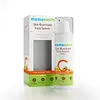What's inside
What's inside
 Key Ingredients
Key Ingredients

 Benefits
Benefits

 Concerns
Concerns

No concerns
 Ingredients Side-by-side
Ingredients Side-by-side

Water
Skin ConditioningNiacinamide
SmoothingButylene Glycol
HumectantTrehalose
HumectantPhenoxyethanol
PreservativeGlycerin
HumectantGlyceryl Glucoside
HumectantMaris Aqua
HumectantGlycine Soja Seed Extract
Skin ConditioningGlycine Soja Extract
Skin ConditioningPotassium Sorbate
PreservativeCitric Acid
BufferingSaccharide Isomerate
HumectantSodium Citrate
BufferingSilica
AbrasiveOryza Sativa Extract
AbsorbentSodium Polyacrylate Starch
AbsorbentSodium Hyaluronate
HumectantDisodium EDTA
Aphanothece Sacrum Polysaccharide
AbsorbentWater, Niacinamide, Butylene Glycol, Trehalose, Phenoxyethanol, Glycerin, Glyceryl Glucoside, Maris Aqua, Glycine Soja Seed Extract, Glycine Soja Extract, Potassium Sorbate, Citric Acid, Saccharide Isomerate, Sodium Citrate, Silica, Oryza Sativa Extract, Sodium Polyacrylate Starch, Sodium Hyaluronate, Disodium EDTA, Aphanothece Sacrum Polysaccharide
Water
Skin ConditioningEthoxydiglycol
HumectantMagnesium Ascorbyl Phosphate
AntioxidantSodium Palmitoyl Proline
Skin ConditioningNymphaea Alba Flower Extract
Skin ConditioningTriheptanoin
Skin ConditioningButylene Glycol
HumectantSodium Hydroxide
BufferingSophora Flavescens Root Extract
AntioxidantGlycyrrhiza Inflata Root Extract
Skin ConditioningScutellaria Baicalensis Root Extract
AstringentAcrylates Crosspolymer
AbsorbentDiethylhexyl Carbonate
EmollientGlycerin
HumectantSqualane
EmollientCaprylhydroxamic Acid
Behenyl Alcohol
EmollientPhysalis Angulata Extract
Skin ProtectingCaprylic/Capric Triglyceride
MaskingTetrahydrocurcumin
AntioxidantCetyl Ricinoleate
EmollientCaesalpinia Spinosa Gum
Skin ConditioningSodium Hyaluronate
HumectantDimethylmethoxy Chromanol
AntioxidantSodium Metabisulfite
AntioxidantWater, Ethoxydiglycol, Magnesium Ascorbyl Phosphate, Sodium Palmitoyl Proline, Nymphaea Alba Flower Extract, Triheptanoin, Butylene Glycol, Sodium Hydroxide, Sophora Flavescens Root Extract, Glycyrrhiza Inflata Root Extract, Scutellaria Baicalensis Root Extract, Acrylates Crosspolymer, Diethylhexyl Carbonate, Glycerin, Squalane, Caprylhydroxamic Acid, Behenyl Alcohol, Physalis Angulata Extract, Caprylic/Capric Triglyceride, Tetrahydrocurcumin, Cetyl Ricinoleate, Caesalpinia Spinosa Gum, Sodium Hyaluronate, Dimethylmethoxy Chromanol, Sodium Metabisulfite
Alternatives
Ingredients Explained
These ingredients are found in both products.
Ingredients higher up in an ingredient list are typically present in a larger amount.
Butylene Glycol (or BG) is used within cosmetic products for a few different reasons:
Overall, Butylene Glycol is a safe and well-rounded ingredient that works well with other ingredients.
Though this ingredient works well with most skin types, some people with sensitive skin may experience a reaction such as allergic rashes, closed comedones, or itchiness.
Learn more about Butylene GlycolGlycerin is already naturally found in your skin. It helps moisturize and protect your skin.
A study from 2016 found glycerin to be more effective as a humectant than AHAs and hyaluronic acid.
As a humectant, it helps the skin stay hydrated by pulling moisture to your skin. The low molecular weight of glycerin allows it to pull moisture into the deeper layers of your skin.
Hydrated skin improves your skin barrier; Your skin barrier helps protect against irritants and bacteria.
Glycerin has also been found to have antimicrobial and antiviral properties. Due to these properties, glycerin is often used in wound and burn treatments.
In cosmetics, glycerin is usually derived from plants such as soybean or palm. However, it can also be sourced from animals, such as tallow or animal fat.
This ingredient is organic, colorless, odorless, and non-toxic.
Glycerin is the name for this ingredient in American English. British English uses Glycerol/Glycerine.
Learn more about GlycerinSodium Hyaluronate is hyaluronic acid's salt form. It is commonly derived from the sodium salt of hyaluronic acid.
Like hyaluronic acid, it is great at holding water and acts as a humectant. This makes it a great skin hydrating ingredient.
Sodium Hyaluronate is naturally occurring in our bodies and is mostly found in eye fluid and joints.
These are some other common types of Hyaluronic Acid:
Learn more about Sodium HyaluronateWater. It's the most common cosmetic ingredient of all. You'll usually see it at the top of ingredient lists, meaning that it makes up the largest part of the product.
So why is it so popular? Water most often acts as a solvent - this means that it helps dissolve other ingredients into the formulation.
You'll also recognize water as that liquid we all need to stay alive. If you see this, drink a glass of water. Stay hydrated!
Learn more about Water